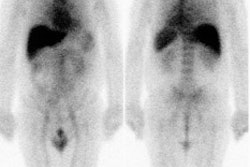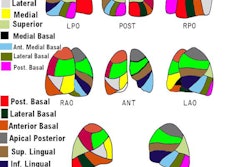Other Radionuclide Agents used for Tumor Therapy
Samarium-153 Ethylene Diamine Tetramethylene Phosporic Acid: (EDTMP)
Samarium-153 lexidronam (Quadramet)
Chemistry and Pharmacology:
Samarium-153 is reactor-produced in high radionuclide purity by neutron bombardment of enriched Sm-152 [4]. It has a physical half-life of 46.3 hours (1.93 days) [5]. It decays with emissions of both beta and gamma particles. It has beta emissions of 640 keV (30%), 710 keV (50%), and 810 keV (20%). These emissions do not penetrate deeply into soft tissues. The gamma emission has an energy of 103 keV (28% abundance) which is adequate for imaging and allows specific localization of metastases which have accumulated the tracer. The agent is complexed with the chelator EDTMP and is supplied as 153-Sm-lexidronam [4]. Following administration the agent is rapidly cleared from the blood (usually within one hour). Because of the shorter half life, a higher dose can be administered compared to Sr-89. However, because of the short half-life the agent may not be available on short notice from suppliers.
Dose:
The agent is given intravenously 1.0mCi (37MBq)/kg (generally 60-80 mCi). Upon return of bone pain, the agent can be re-administered. Additionally, treatment with this agent does not preclude sequential use of supplemental pain relief with other approaches such as focal external radiation or analgesics.
Distribution
Following intravenous administration the agent is rapidly taken up by the skeleton in osteoblastic bone metastases. Less than 1% of the dose remains in the blood at 5 hours [5]. Between 45-95% (30-50% [8]) of dose localizes to the skeleton through chemisorption on the surface of the hydroxyapatite molecule [5] (complexes to phosphate for bone targeting). Between 2-13% of the dose localizes to non-osseous tissues (mostly the liver). Any of the compound that is not taken up by bone undergoes rapid renal excretion and excretion is almost complete within 6 hours of administration [4]. However, there is a large inter-patient variability in the urinary clearance and bone retention depending on the extent of bone metastases [4]. The mean bone uptake for 153Sm-EDTMP is more than twice that for 186Re-HEDP [3]. The concentration in metastases is about 14 times as large as normal bone after one day [6]. After 7 days, the activity in metastases is still 8 times as high as normal bone [6].
Indications
In the palliation of painful bone mets between 62-84% of patients treated with Samarium-153 experienced symptomatic (partial or complete) relief of bone pain [5,8] typically within 5 to 10 days of administration. This rapid response is a benefit to the patient from the stand point of prompt relief of pain. The mean duration of benefit is 2 to 4 months. Pain flare is not commonly (about 10% of patients) [7]. On follow-up imaging after therapy, the size and number of metastases has been shown to decrease in about one-third of patients [6].
Retreatment with Sm-153 is safe, feasible, and can efficacious [4]. Sm-153 should not be administered on the same day as other biphosphonates as both agents compete for the same binding sites on the hydroxyapatite crystal associated with new bone formation [4].
Complications
Complications of Samarium-153 treatment include a mild transient myelosupression (white blood cells and platelets) with a nadir at a median of 4 weeks and recovery after approximately 4 to 8 weeks. WBC counts can decrease as much as 40-50% from baseline [4]. The severity of the drop in platelet count appears to be dose related [6]. Toxicity is greater in patients with extensive tumor in the bone marrow and in those receiving chemotherapy at the same time [6].
REFERENCES:
(1) J Nucl Med 1989; Singh A, et al. Human pharmacokinetics of samarium-153 EDTMP in metastatic cancer. 30: 1814-1818
(2) J Nucl Med 1991; Heggie JC. Radiation absorbed dose calculations for samarium-153-EDTMP localized in bone. 32: 840-844
(3) J Nucl Med 2001; Brenner W, et al. Skeletal uptake and soft-tissue retention of 186-Re-HEDP and 153Sm-EDTMP in patients with metastatic bone disease. 42: 230-236
(4) J Nucl Med 2001; Serafini AN. Therapy of metastatic bone pain. 42: 895-906
(5) Semin Radiat Oncol 2000; Silberstein EB. Systemic radiopharmaceutical therapy of painful osteoblastic metastases. 10: 240-249
(6) The Journal of Radiology 2002; Deng H, et al. Radiopharmaceutical (Sm-153-EDTMP) therapy of skeletal metastases: clinical application in 350 patients. www.jradiology.org
(7) J Nucl Med 2005; Lewington VJ. Bone-seeking radionuclides for
therapy. 184: 38S-47S
(8) J Nucl Med 2011; Biersack HJ, et al. Palliation and survival after repeated . 188Re-HEDP therapy of hormone-refractory bone metastases of prostate cancer: a retrospective analysis. 52: 1721-1726
Rhenium-186 hydroxyethylidene diphosphate (HEDP):
Chemistry and Pharmacology/ Distribution:
Rhenium-186 has a physical half-life of 89 hours (3.7 days) and
beta emissions of 1.08 MeV (max energy) and 970 keV. These
particles have a mean range of 0.5 mm in bone and 1 mm in soft
tissues [7]. It also has a gamma emission of 137 keV (9%
abundance) which can be used to image the distribution of the
agent in order to assess its effectiveness and quantify the
radiation dose. The agent is complexed with a phosphate ligand for
targeting to bone and it clears rapidly from the blood pool. Peak
skeletal uptake occurs 3 hours after I.V. administration [6]. The
mean biologic half-life in bone metastases ranges between 45 to 59
hours [6]. Excretion is primarily renal with 45% of the total dose
excreted by 5 hours and 69% +/- 15% of the injected activity
excreted over the first 24 hours [6]. At 24 hours following
injection, between 12-30% of the agent remains localized in bone
[2]. This agent is not approved for use in the USA and it has also
been withdrawn from the European market [8]. 188Re-HEDP
may be a more effective therapeutic agent, but it is not
commercially available [8].
Rhenium-186 for Palliation of Painful Mets:
Between 54% to 80% of patients treated with a 35 mCi dose experienced pain relief or a decrease in analgesic requirements. In comparison to placebo, patients treated with Rh-186 experienced a longer pain response [4]. Response is typically rapid (within 24-48 hours) [6]. The average duration of pain relief is 30 to 45 days, but some patients remain pain free for up to 12 months. Between 10% to 42% (up to 50%) of patients may experience a transient flare of increased pain from 2 to 3 days up to 2 weeks after the treatment. The intensity of this pain is usually moderate to severe and usually resolves spontaneously in a few days. Analgesics can be used as required [6]. There is no relationship between the occurence of a flare reaction and the response to treatment [1]. The agent does not induce tumor regression [1]. Patients with prostate cancer metastases may have a better response than patients with breast cancer [1].
Complications of Rhenium-186 Treatment:
A 35 mCi dose of Rhenium-186 delivers about 75 rads to the bone marrow. Mild transient myelosupression reflected by an approximately 15% to 38% decrease in platelets and about a 10% to 30% decrease in white blood cells can be detected between 4 to 6 weeks following injection. Spontaneous recovery to pretreatment levels occurs by 8 weeks [6].
REFERENCES:
(1) J Nucl Med 2000; Kolesnikov-Gauthier H, et al. Evaluation of toxicity and efficacy of 186Re-Hydroxyethylidene diphosphonate in patients with painful metastases of prostate and breast cancer. 41: 1689-1694
(2) J Nucl Med 2001; Brenner W, et al. Skeletal uptake and soft-tissue retention of 186-Re-HEDP and 153Sm-EDTMP in patients with metastatic bone disease. 42: 230-236
(3) J Nucl Med 2001; Serafini AN. Therapy of metastatic bone pain. 42: 895-906
(4) J Nucl Med 2002; Han SH, et al. The Placorhen study: a double-blind, placebo controlled, randomized radionuclide study with 186Re-etidronate in hormone-resistant prostate cancer patients with painful bone metastases. 43: 1150-1156
(5) J Nucl Med 2004; Pandit-Taskar N, et al. Radiopharmaceutical therapy for palliation of bone pain from osseous metastases. 45: 1358-1365
(6) J Nucl Med 2005; Lewington VJ. Bone-seeking radionuclides for therapy. 184: 38S-47S
(7) J Nucl Med 2006; Syed R, et al. 186Re-HEDP in the
treatment of patients with inoperable osteosarcoma. 47: 1927-1935
(8) J Nucl Med 2011; Biersack HJ, et al. Palliation and survival
after repeated . 188Re-HEDP therapy of
hormone-refractory bone metastases of prostate cancer: a
retrospective analysis. 52: 1721-1726
177Lu-DOTATATE
therapy




















